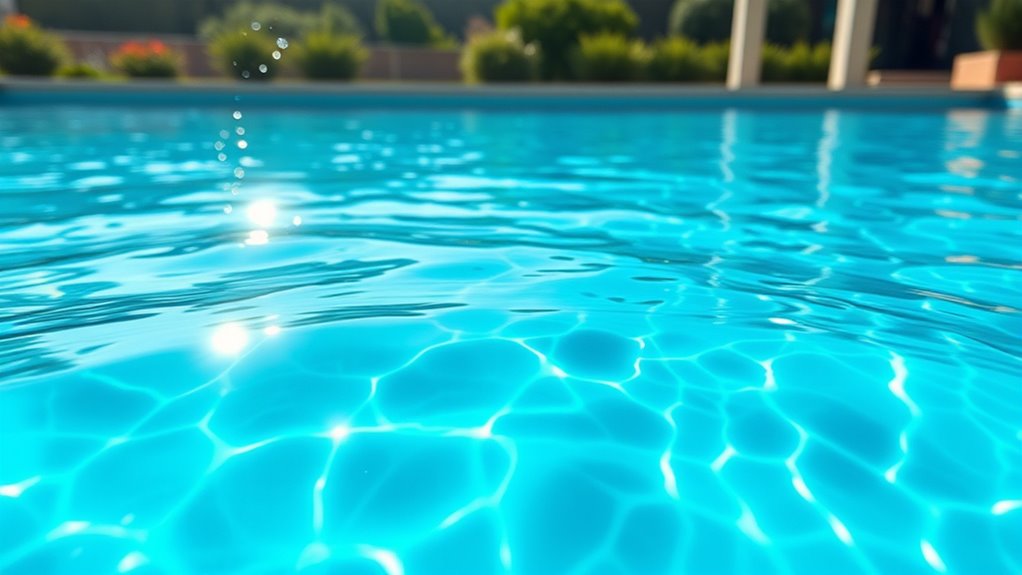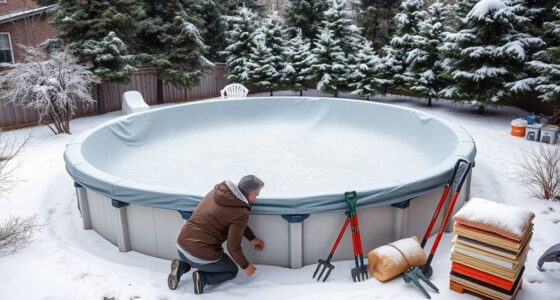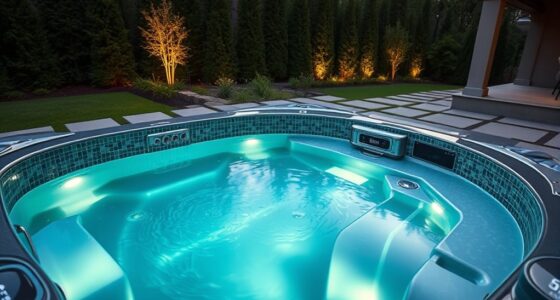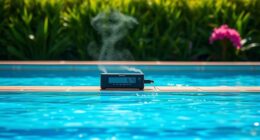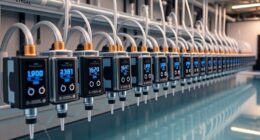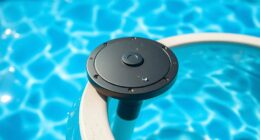To balance free and combined chlorine, regularly test your water and keep free chlorine levels between 1-3 ppm, while maintaining combined chlorine below 0.2 ppm. Proper pH levels between 7.2 and 7.6 help chlorine work effectively. If combined chlorine rises, a shock treatment can restore water clarity and sanitation. Managing circulation, filtration, and organic contaminants will also help. Keep these practices in mind, and you’ll be able to achieve and maintain a healthy pool environment.
Key Takeaways
- Regularly test chlorine levels to monitor free chlorine and combined chlorine concentrations.
- Maintain pH between 7.2 and 7.6 to optimize chlorine stability and effectiveness.
- Keep combined chlorine below 0.2 ppm to ensure proper sanitation and reduce chloramine buildup.
- Use shock treatments when combined chlorine exceeds recommended levels to restore water quality.
- Ensure proper circulation, filtration, and cleaning to prevent organic buildup that increases chloramine formation.
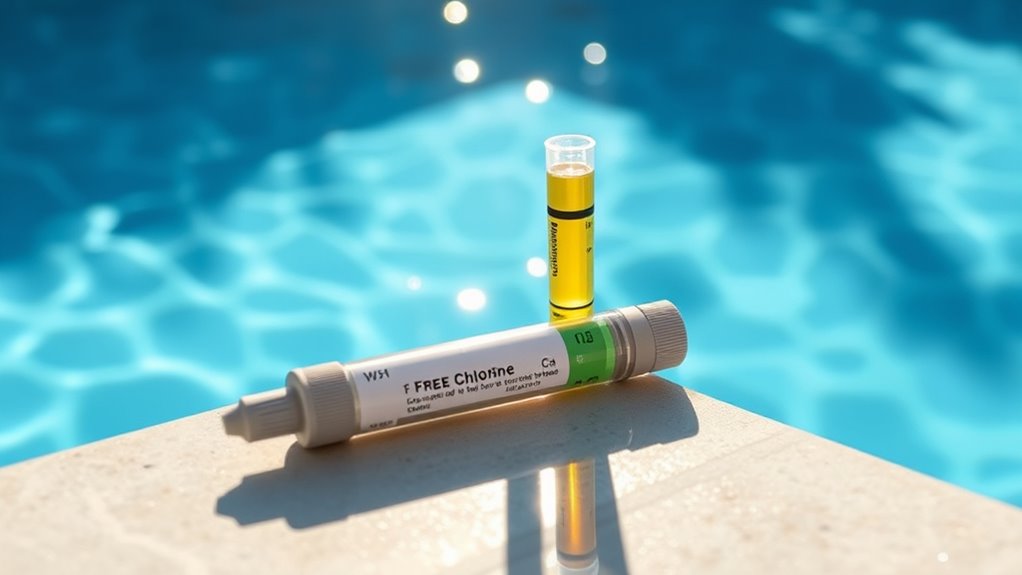
Have you ever wondered how to keep your pool safe and clean without overusing chemicals? Achieving the perfect balance between free chlorine and combined chlorine is essential to maintaining clear, healthy water. When you focus on chlorine stability, you help ensure that your sanitizer remains effective longer, reducing the need for frequent additions. Chlorine stability depends on factors like sunlight, temperature, and water chemistry, so understanding how to maintain it can make your pool maintenance much easier. One key aspect is pH adjustment. If your pH levels are too high or too low, chlorine becomes less effective, leading to poor sanitation and cloudy water. Keeping your pH within the ideal range of 7.2 to 7.6 helps maximize chlorine stability, so your sanitizer works efficiently without constantly adding more chemicals. Proper circulation and filtration also play a crucial role in maintaining chlorine effectiveness, as water movement helps distribute chlorine evenly throughout the pool. To balance free and combined chlorine, you need to regularly test your water. Free chlorine is the active form that kills bacteria and algae, while combined chlorine, or chloramines, forms when free chlorine reacts with organic contaminants like sweat, oils, or urine. High levels of combined chlorine not only reduce sanitation effectiveness but also create unpleasant odors and eye irritation. To keep your water safe and fresh, aim to keep combined chlorine below 0.2 parts per million (ppm). If it rises above this, it’s time for a shock treatment—adding a large dose of chlorine to break down chloramines and restore water quality. Managing chlorine levels involves more than just adding chemicals. Proper circulation and filtration are critical; if water isn’t moving well, chlorine won’t distribute evenly, and stagnation can promote harmful bacteria growth. Regularly brushing the pool walls and vacuuming debris also helps reduce organic matter that consumes free chlorine and creates chloramines. Remember, maintaining proper pH adjustment is intertwined with chlorine stability. When pH drifts out of the ideal range, chlorine’s ability to disinfect diminishes, and you may find yourself battling cloudy water or algae growth. Consequently, testing your water frequently and adjusting pH as needed guarantees your chlorine remains potent and stable.
Frequently Asked Questions
How Does Ph Affect Free and Combined Chlorine Levels?
Your pH level greatly influences chlorine stability and the balance between free and combined chlorine. When pH is too high, free chlorine becomes less effective because it shifts toward less active forms. Conversely, low pH can cause chlorine to form more combined chlorine, which reduces sanitation efficiency. Maintaining a proper pH guarantees ideal chlorine performance, keeping your pool safe and clean by supporting the right balance of free and combined chlorine.
What Are the Health Risks of Improper Chlorine Balancing?
If you don’t properly balance chlorine, you risk chlorine overdose, which can cause skin irritation, rashes, or even respiratory issues. Improper levels may also lead to ineffective disinfection, increasing the chance of bacteria or algae growth. This can compromise water safety and your health. Always monitor chlorine levels closely to prevent these risks, ensuring your pool remains safe and comfortable for everyone.
How Often Should I Test Chlorine Levels in My Pool?
You should test your pool’s chlorine levels at least 2-3 times a week to guarantee proper chlorine maintenance. Even if your pool looks clear, regular testing prevents imbalances that can cause health issues or algae growth. During heavy use or after rain, test more frequently. Consistent testing frequency helps you maintain safe, clean water, giving you peace of mind and a healthier swimming environment.
Can Natural Methods Reduce Combined Chlorine?
Yes, natural methods like organic treatment and natural filtration can help reduce combined chlorine in your pool. Organic treatments, such as adding beneficial enzymes or natural clarifiers, break down chloramines, while natural filtration improves water circulation and removes contaminants that contribute to combined chlorine. Regularly shocking your pool with a non-chemical method, like mineral-based shock, also supports these natural processes, keeping your water cleaner and healthier.
What Equipment Is Best for Measuring Chlorine Accurately?
Think of your pool as a delicate symphony; you need the right tools to keep it in tune. Chlorine analyzers are your precision instruments, offering real-time, accurate readings that sing in harmony. Test kits, on the other hand, are your trusty magnifying glass, helping you double-check levels. Both are essential; choose high-quality options to guarantee your pool’s chemistry stays balanced, safe, and sparkling.
Conclusion
To keep your pool safe and inviting, balancing free and combined chlorine is essential. When done right, you can reduce chloramine levels by up to 90%, markedly improving water quality and swimmer comfort. Remember, maintaining proper chlorine levels not only prevents unpleasant odors but also minimizes health risks. By staying vigilant and regularly testing your water, you ensure a cleaner, healthier swimming environment for everyone to enjoy.
